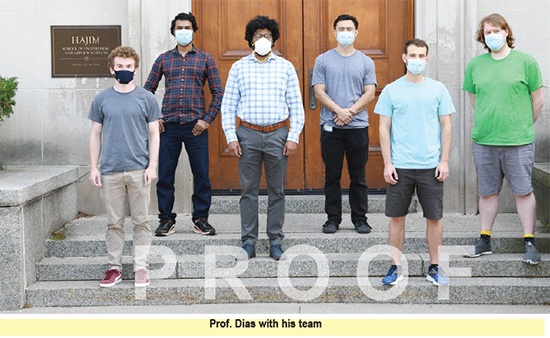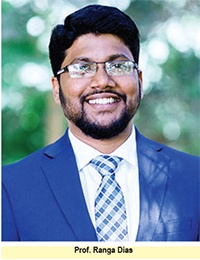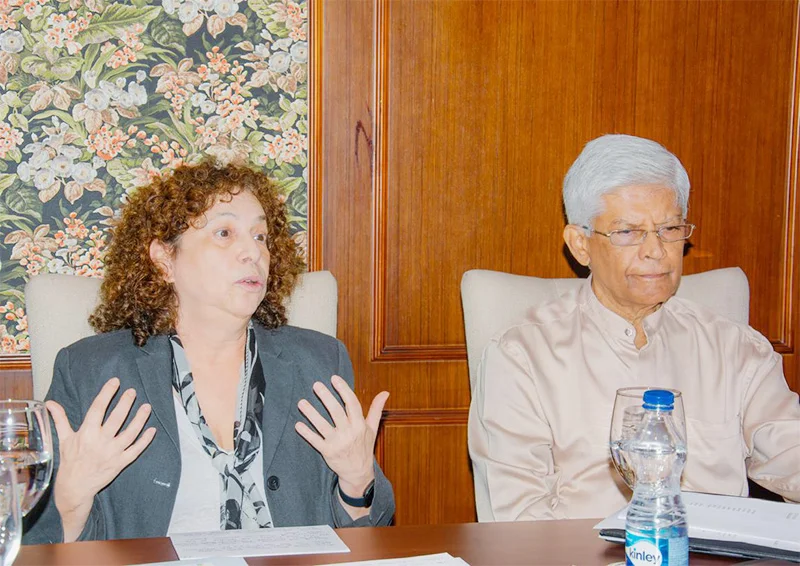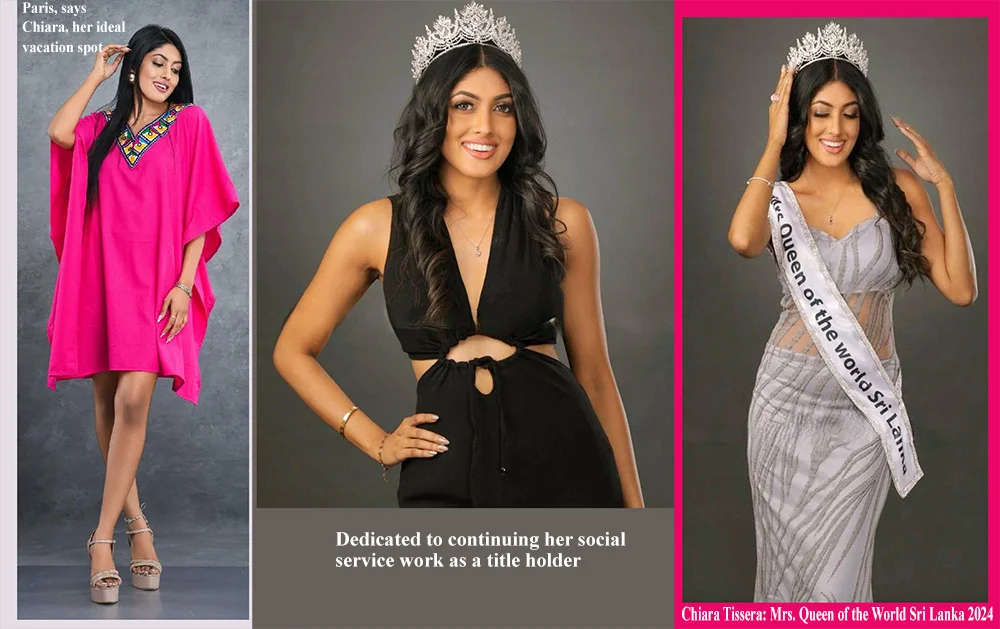Features
Sri Lankan pioneering superconductivity research

Prof Ranga Dias and team make world’s first-ever room-temperature superconductor
By Sajitha Prematunge
It is not a vaccine for COVID-19, but it could be the next best thing. The world’s first superconductor at room temperature, developed by a research team lead by Sri Lankan born physicist, Prof. Ranga Dias at the University of Rochester, USA, could potentially revolutionise everything from transport to energy industry.
The team recently discovered carbonaceous sulphur hydride (CSH), a new compound that acts as a superconductor at 15 °C at a pressure of 267 Giga Pascals (Gpa), or 2.6 million atmospheres (75 percent of the pressure at the earth’s core). The heady article in Nature magazine, which published this groundbreaking discovery in its cover story on October 15, may sound gobbledygook for some. Consequently, The Island interviewed University of Rochester, USA, Department of Physics and Astronomy and Department of Mechanical Engineering, Assistant professor Prof. Ranga Dias; Ph.D. student in Physics, Hiranya Pasan and Ph.D. candidate in Optics, Ashan Ariyawansa to put things in perspective.
A superconductor is a materiel that poses no electrical resistance. “We used two diamonds, each approximately 150 to 200 micron in diameter, on top of each other, to make what’s called a diamond anvil cell. The sample was sandwiched between the two diamonds and pressure applied.” Pasan explained that they could achieve pressures of up to 500 Giga Pascals with the diamond anvil cell. “For comparison, that’s more than the pressure at the earth’s core,” said Pasan. “The diamond anvil cell acts as a materiel search engine, that we use to test material at different pressure until we found the ideal conditions to achieve superconductivity for each material, allowing us to determine which materiel is the most effective. And the result was CSH, a compound belonging to a new class of dense hydrogen rich material.
What took so long?
 Even though their work was based on old theory, in existence for more than a century, there is still a lot of unknowns. “Even established theory does not explain the mechanism that goes into the making of a superconducting material,” said Dias. But they had two criteria going for them, the ideal superconductor should be of a lighter element that can make stronger bonds. This was the basic premise under which Dias and his team started working with carbon and sulphur. “Our success depended on the right elemental combination,” said Dias, a researcher on high-pressure physics, who had been working with carbon and sulfur for just over a decade.
Even though their work was based on old theory, in existence for more than a century, there is still a lot of unknowns. “Even established theory does not explain the mechanism that goes into the making of a superconducting material,” said Dias. But they had two criteria going for them, the ideal superconductor should be of a lighter element that can make stronger bonds. This was the basic premise under which Dias and his team started working with carbon and sulphur. “Our success depended on the right elemental combination,” said Dias, a researcher on high-pressure physics, who had been working with carbon and sulfur for just over a decade.
Pressure variations can convert basic elements of the periodic table into something completely different. Dias explained complex high-pressure physics with a simple analogy. There are two people in a room who can’t interact with each other because they are on opposite corners of the room. Now have the walls close in on them until they are able to talk, shake hands and interact. “The same principle can be applied to elements. When pressurized, atoms and molecules become more interactive and make new bonds. This alters the actual chemical nature of the compound. That’s the beauty of high-pressure physics, it allows you to manipulate the identity of compounds to create whole new material with completely unexpected properties,” said Dias.
Previous research
Dias holds a Bachelor of Science degree from the University of Colombo. He turned his attention to metallic hydrogen research as an extension of his PhD research on high-pressure physics at the University of Washington. In 2017, Dias, then a postdoctoral fellow at Harvard University and Isaac Silvera, physicist at Harvard announced the discovery of metallic hydrogen in the Science magazine. Their experiment involved compressing hydrogen gas, which liquifies when cooled to minus 423 degrees Fahrenheit (minus 252.778 Celsius), and then solidifying it at lower temperatures. The claim came under heavy criticism for being based on a single observation, on reflectivity (an expected signature of metallic hydrogen), and without a direct measurement of the pressure involved. The original ‘metallic hydrogen’ sample was lost during the subsequent failure of the diamond anvil cell. Prof. Dias said: “It was a complete study. What is left is to describe the properties of metallic hydrogen, which we are actively working on. Research takes time. None of these experiments are easy.” He joined the University of Rochester, in 2017 as a professor, and is currently conducting further research on metallic hydrogen. He further explained that the Harvard group measured the pressure directly using standard methods that any high-pressure scientist used. Every high-pressure experiment ended with the failure of the diamond anvil cell, which means the loss of the sample. Consequently, Dias argued that there was nothing unusual about the fact that their diamond broke, resulting in the loss of the sample. “I think fellow competitors who were trying to make metallic hydrogen wasn’t happy that we got it right, their criticism has nothing to do with science but rather was a political attack on my previous advisor [Silvera].”
When asked how positive he is about the newly discovered carbonaceous sulphur hydride, in light of the previous backlash, Dias said that he doubted there was a connection. “They are two different experiments and very different samples. The hallmark of superconductivity is the complete absence of electrical resistance. And another property of superconducting materials is that when it is cooled below the superconducting transition temperature, the magnetic field lines are expelled from the material. We have observed both of these key properties on our carbonaceous sulphur hydride materials at high pressures.” Dias confident of the results.
Prof. Dias’ finding has definitely sparked investor interest. In fact, investors are already lining up to fund a research company, by the name of ‘Unearthly Materials’, set up under the leadership of Prof. Dias to carry out further research and to manufacture superconductors on a large scale. A financial capital of US $ 2 million, has already been provided by investors. Dias hopes it will culminate in a highly productive venture in three to five years.
Implications
Prof. Dias believes that the technology could open up a world of possibilities for medical imaging such as MRI, computing and consumer electronics such as mobile phones. Applications of his discovery include low-cost MRI scanners, magnetic levitation trains, and power lines with no electrical resistance. “A computer, for example, has a heavy cooling system with heat sink, fans and the like, but with a superconductor none of these will be necessary,” explained Hiranya Pasan, who was tasked with low temperature analysis in this research. With this kind of tech everything from car radiators to train tracks could become redundant. “A huge amount of energy is lost in transmission per year. It adds up to a lot of money,” pointed out Pasan. So, if someone were to mass produce superconducting wire, which offers no electrical resistance, he would save billions of or dollars for countless governments.
And then there is the Meissner effect, which in layman’s terms means to repel a magnet. Superconductors are strongly diamagnetic and expel magnetic fields. As such trains could employ magnets that levitate on superconducting material. “It produces no friction,” explained Pasan. Such frictionless high-speed trains could revolutionise the transport sector.
“The technology already exists,” explained Dias. Superconducting technology is used in MRI scanners, particle accelerators, and magnetic levitation trains of experimental scale in Japan, all of which involves large magnetic fields. “But it requires cryogenics.” Meaning that some metals reach superconductivity at extremely cold temperatures and, therefore, have to be cooled to about 10 to 20 Kelvin. For context, that’s minus 263.15 to 253.15 Celsius. The critical temperature of the first superconductor, discovered in 1911, was minus 269 °C, and the fact that no research has ever been able to find a material that acts as a superconductor in room temperature has been one of the major challenges in physics.
“The cryogenic factor is what makes the technology so expensive and therefore economically unviable,” pointed out Dias. So, if cryogenics were to be taken out of the equation, it would make medical imaging, for example, much more affordable and efficient. Prof. Dias explained that liquid helium is the most widely used coolant in superconducting applications, a resource fast diminishing.
He and his team were able to take the cryogenics out of the equation, but maintaining such gargantuan pressures make mass production of superconducting material virtually impossible. When asked how stable the new compound was Dias explained that CSH could be metastable, meaning that it may not revert to the original compound of carbon and sulphur once pressure is relieved. If not, it’s back to square one for the team as they would have to find another compound that acts as a superconductor at both room temperature and atmospheric pressure. The team revealed that they would conduct the ultimate experiment by relieving pressure, in the weeks to come, which Pasan has been tasked with. “Once we have a metastable superconducting material at ambient pressure, it’s just a matter of replicating it, using techniques like chemical deposition and Molecular-beam epitaxy (MBE), to achieve mass production.” Those were the standard techniques and therefore were affordable, he said.
Ground-breaking discoveries are made every few decades in the western world and they have little or no effect at all on developing nations such as Sri Lanka. So why is a superconductor at room temperature even significant for a country like Sri Lanka? “I don’t think that the GDP matters in terms of implications of such discoveries, said Dias. “What is rocket science is developing a superconductor at room temperature. When that’s a reality, application comes easy. Whether it was frictionless trains or MRI scanners, such technology can always be applied by replacing the existing technology with the new.”
Application of such technology in quantum computing would be difficult for a country like Sri Lanka, but Dias pointed out that the implications of the technology for energy transmission was of considerable significance to developing countries. As Pasan pointed out, a lot of electricity is lost during transmission. Dias argued that with a superconducting wire, that pose no resistance, third world power generation can be made more efficient, thereby increasing capacity. “This kind of application is not difficult to apply even in a developing country.” Dias assured that such technology would be affordable even for developing countries.
Local students
When asked about the practical difficulties Sri Lankan students have to face, Hiranya pointed out that as opposed to Sri Lanka, the US has a more student-centred education system, while Dias said there was a clear lack of enthusiasm for research in Sri Lanka. “During my time in Sri Lanka, we were hardly exposed to experiments, we rarely saw instruments, except at practicals during undergraduate years, simply because we didn’t have the facilities,” said Prof. Dias. “The system is exam-oriented, and as a result we lacked hands on experience.” Dias pointed out that in the US education system there was ample opportunity for research. “Even the exam questions here are very practical. It hones critical thinking instead of promoting memorising equations and just getting good grades.” Such a system increases research productivity, he said.
“Research lacks support in Sri Lanka, especially in terms of funding,” said Dias. “In the States we can acquire federal, corporate and other sources of funding. But in Sri Lanka we don’t have that kind of a mechanism.”
But things are looking up, said Ariyawansa. “Collaborative research on chemistry and biotechnology is undertaken increasingly in Sri Lanka,” he said, pointing out that industrial chemistry and nanotechnology were fast developing areas, but he admitted that physics was still lagging behind. “We now have institutions such as SLINTEC [Sri Lanka Institute of Nanotechnology], which has succeeded in attracting a lot of expatriate academics back into the country,” added Dias. He opined that such infrastructural support and funding would facilitate cutting-edge research.
When asked whether such cutting-edge research would have any practical applications in Sri Lanka and whether putting so much money and effort into research was viable in the absence of practical applications, Prof. Dias said that there would always be opportunities in terms of putting research into practice. “Commercial production of graphene by SLINTEC is a case in point. It’s a direct application. I’m sure that if Sri Lanka can produce high grade graphene, we can export it. Graphene has a lot of applications, especially in electronics. It’s used widely in the US, Japan, Europe and South Korea for semiconductor and mobile applications.”
The same principle can be applied to diamonds. “With the right combinations of material diamonds can be grown in the lab,” Dias pointed out that this could revolutionise the diamond industry. “This is already being done in the US,” said Dias, reiterating that material research would always have applications.
Features
SL urged to use GSP+ to the fullest to promote export development

 Sri Lanka needs to take full stock of its current economic situation and use to the maximum the potential in its GSP+ facility for export sector growth. In the process, it should ensure that it cooperates fully with the European Union. The urgency of undertaking these responsibilities is underscored by the issues growing out of the recent US decision to sweepingly hike tariffs on its imports, though differentially.
Sri Lanka needs to take full stock of its current economic situation and use to the maximum the potential in its GSP+ facility for export sector growth. In the process, it should ensure that it cooperates fully with the European Union. The urgency of undertaking these responsibilities is underscored by the issues growing out of the recent US decision to sweepingly hike tariffs on its imports, though differentially.
These were principal ‘takes’ for participants in the Pathfinder Foundation’s Ambassadors’ Roundtable forum held on April 8th at the Colombo Club of the Taj Samudra. The main presenter at the event was Ms. Carmen Moreno Raymundo, Ambassador of the European Union to Sri Lanka and the Maldives. The forum was chaired by Ambassador Bernard Goonetilleke, Chairman, Pathfinder Foundation. The event brought together a cross-section of the local public, including the media.
Ms. Moreno drew attention to the fact Sri Lanka is at present severely under utilizing its GSP+ facility, which is the main means for Sri Lanka to enter the very vast EU market of 450 million people. In fact the EU has been Sri Lanka’s biggest trading partner. In 2023, for instance, total trade between the partners stood at Euros 3.84 billion. There is no greater market but the EU region for Sri Lanka.
‘However, only Sri Lanka’s apparel sector has seen considerable growth over the years. It is the only export sector in Sri Lanka which could be said to be fully developed. However, wider ranging export growth is possible provided Sri Lanka exploits to the fullest the opportunities presented by GSP+.’
Moreno added, among other things: ‘Sri Lanka is one among only eight countries that have been granted the EU’s GSP+ facility. The wide-ranging export possibilities opened by the facility are waiting to be utilized. In the process, the country needs to participate in world trade in a dynamic way. It cannot opt for a closed economy. As long as economic vibrancy remains unachieved, Sri Lanka cannot enter into world trading arrangements from a strong position. Among other things, Sri Lanka must access the tools that will enable it to spot and make full use of export opportunities.
‘Sri Lanka must facilitate the private sector in a major way and make it possible for foreign investors to enter the local economy with no hassle and compete for local business opportunities unfettered. At present, Lanka lacks the relevant legal framework to make all this happen satisfactorily.
‘Sri Lanka cannot opt for what could be seen as opaque arrangements with bilateral economic partners. Transparency must be made to prevail in its dealings with investors and other relevant quarters. It’s the public good that must be ensured. The EU would like to see the local economy further opening up for foreign investment.
‘However, it is important that Sri Lanka cooperates with the EU in the latter’s efforts to bring about beneficial outcomes for Sri Lankans. Cooperation could be ensured by Sri Lanka fully abiding by the EU conditions that are attendant on the granting of GSP+. There are, for example, a number of commitments and international conventions that Sri Lanka signed up to and had promised to implement on its receipt of GSP+ which have hitherto not been complied with. Some of these relate to human rights and labour regulations.
‘Successive governments have pledged to implement these conventions but thus far nothing has happened by way of compliance. GSP+ must be seen as an opportunity and not a threat and by complying with EU conditions the best fruits could be reaped from GSP+. It is relevant to remember that GSP+ was granted to Sri Lanka in 2005. It was suspended five years later and restored in 2017.
‘The importance of compliance with EU conditions is greatly enhanced at present in view of the fact that Sri Lanka is currently being monitored by the EU with regard to compliance ahead of extending GSP+ next year. A report on Sri Lanka is due next year wherein the country’s performance with regard to cooperating with the EU would be assessed. The continuation of the facility depends on the degree of cooperation.
‘A few statistics would bear out the importance of Sri Lanka’s partnership with the EU. For example, under the facility Sri Lanka benefits from duty free access in over 66% of EU tariff lines. The highest number of tourist arrivals in Sri Lanka in 2023 was from the EU’s 27 member states. Likewise, the EU’s 27 member states rank second in the origin of inflows of foreign exchange to Sri Lanka; with Italy, France and Germany figuring as the main countries of origin. Eighty five percent of Sri Lanka’s exports to the EU market benefits from GSP+. Thus, the stakes for the country are high.’
Meanwhile, President, In-house Counsel & Legal Advisor, The European Chamber of Commerce of Sri Lanka, John Wilson said: ‘GSP+ should be seen as not only an opportunity but also as a necessity by Sri Lanka in the current international economic climate. ‘Implementation of local laws is what is needed. Considering the pressures growing out of the US imposed new tariff regime, a good dialogue with the EU is needed.
‘Sri Lanka’s level of business readiness must be upped. Among the imperatives are: An electronic procurement process, Customs reforms, a ‘National Single Window’, stepped-up access to land by investors, for example, a clear policy framework on PPPs and reform of the work permits system.’
It ought to be plain to see from the foregoing that Sri Lanka cannot afford to lose the GSP+ facility if it is stepped-up economic growth that is aimed at. It would be in Sri Lanka’s best interests to remain linked with the EU, considering the aggravated material hardships that could come in the wake of the imposition of the US’ new tariff regime. Sri Lanka would need to remain in a dialogue process with the EU, voice its reservations on matters growing out of GSP+, if any, iron out differences and ensure that its national interest is secured.
Features
SENSITIVE AND PASSIONATE…

Chit-Chat
Chiara Tissera
Mrs. Queen of the World Sri Lanka 2024, Chiara Tissera, leaves for the finals, in the USA, next month
I had a very interesting chat with her and this is how it all went:
1. How would you describe yourself?
I am a sensitive and passionate individual who deeply cares about the things that matter most to me. I approach life with a heart full of enthusiasm and a desire to make meaningful connections.
2. If you could change one thing about yourself, what would it be?
Actually, I wouldn’t change a thing about myself because the person I am today, both inside and out, is the result of everything I’ve experienced. Every part of me has shaped who I am, so I embrace both my strengths and imperfections as they make me uniquely me.
3. If you could change one thing about your family, what would it be?
If there’s one thing I could change about my family, it would be having my father back with us. Losing him six years ago left a void that can never be filled, but his memory continues to guide and inspire us every day.
4. School?
I went to St. Jude’s College, Kurana, and I’m really proud to say that the lessons I gained during my time there have shaped who I am today. My school and teachers instilled in me values of hard work, perseverance and the importance of community, and I carry those lessons with me every day. I was a senior prefect and was selected the Deputy Head Prefect of our college during my tenure.
5. Happiest moment?
The happiest moment of my life so far has been winning the Mrs. Sri Lanka 2024 for Queen of the World. It was a dream come true and a truly unforgettable experience, one that fills me with pride and gratitude every time I reflect on it.
6. What is your idea of perfect happiness?
Happiness is a deeply personal and multifaceted feeling that often comes from a sense of contentment, fulfillment and well-being. For me, perfect happiness is in moments of joy, peace and accomplishments … and also being surrounded by my loved ones.
7. Are you religious?
Yes, I’m a very religious person. And I’m a firm believer in God. My faith guides me through life, providing strength, dedication and a sense of peace in every situation. I live by the quote, ‘Do your best, and God will do the rest.’
8. Are you superstitious?
I’m not superstitious. I believe in making my own decisions and relying on logic and faith rather than following superstitions.
9. Your ideal guy?
My ideal guy is my husband. He is compassionate, understanding and is always there to support me, no matter what. He’s my rock and my best friend – truly everything I could ever want in a partner.
10. Which living person do you most admire?
The living person I admire the most is definitely my mummy. Her strength, love and unwavering support has shaped me into who I am today. She is my role model and she inspires me every day with her wisdom and kindness.
11. Your most treasured possession?
My most treasured possession is my family. They are the heart of my life, providing me with love, support and strength. Their presence is my greatest blessing.
12. If you were marooned on a desert island, who would you like as your companion?
I would like to have my spouse as my companion. Together, we could make the best of the situation, supporting each other, sharing moments of laughter and finding creative ways to survive and thrive.
13. Your most embarrassing moment?
There’s quite a few, for sure, but nothing is really coming to mind right now.
14. Done anything daring?
Yes, stepping out of my comfort zone and taking part in a pageant. I had no experience and was nervous about putting myself out there, but I decided to challenge myself and go for it. It pushed me to grow in so many ways—learning to embrace confidence, handle pressure, and appreciate my own uniqueness. The experience not only boosted my self-esteem but also taught me the value of taking risks and embracing new opportunities, even when they feel intimidating.”
15. Your ideal vacation?
It would be to Paris. The city has such a magical vibe and, of course, exploring the magical Eiffel Tower is in my bucket list. Especially the city being a mix of history culture and modern life in a way that feels timeless, I find it to be the ideal vacation spot for me.
16. What kind of music are you into?
I love romantic songs. I’m drawn to its emotional depth and the way they express love, longing a connection. Whether it’s a slow ballad, a classic love song or a more modern romantic tune these songs speak to my heart.
17. Favourite radio station?
I don’t have a specific radio station that I like, but I tend to enjoy a variety of stations, depending on my mood. Sometimes I’ll tune into one for a mix of popular hits, other times I might go for something more relaxing, or a station with a certain vibe. So I just like to keep it flexible and switch it up.
18. Favourite TV station?
I hardly find the time to sit down and watch TV. But, whenever I do find a little spare time, I tend to do some spontaneous binge – watching, catching whatever interesting show is on at that moment.
19 What would you like to be born as in your next life?
Mmmm, I’ve actually not thought about it, but I’d love to be born as someone who gets to explore the world freely – perhaps a bird soaring across continents.
20. Any major plans for the future?
Let’s say preparing and participating in the international pageant happening in the USA this May. It’s an exciting opportunity to represent myself and my country on a global stage. Alongside this, I am dedicated to continuing my social service work as a title holder, striving to make a meaningful difference in the lives of others through my platform.
Features
Fresher looking skin …

 The formation of wrinkles and fine lines is part of our ageing process. However, if these wrinkles negatively impact appearance, making one look older than they actually are, then trying out some homemade remedies, I’ve listed for you, this week, may help in giving your skin a fresher look.
The formation of wrinkles and fine lines is part of our ageing process. However, if these wrinkles negatively impact appearance, making one look older than they actually are, then trying out some homemade remedies, I’ve listed for you, this week, may help in giving your skin a fresher look.
* Banana:
Bananas are considered to be our skin’s best friend. They contain natural oils and vitamins that work very perfectly to boost our skin health. Skincare experts recommend applying the banana paste to the skin.
Take a ripe banana and mash a quarter of it until it becomes a smooth paste. Apply a thin layer of the banana paste on your skin and allow it to sit for 15 to 20 minutes before washing it off with warm water.
* Olive Oil:
Olive oil works as a great skin protector and many types of research suggest that even consuming olive oil may protect the skin from developing more wrinkles. Olive oil contains compounds that can increase the skin’s collagen levels. Yes, olive oil can be used as a dressing on your salads, or other food, if you want to consume it, otherwise, you can apply a thin layer of olive oil on your face, neck and hands and let it stay overnight.
* Ginger:
Ginger serves to be a brilliant anti-wrinkle remedy because of the high content of antioxidants in it. Ginger helps in breaking down elastin, which is one of the main reasons for wrinkles. You can have ginger tea or grate ginger and have it with honey, on a regular basis.
* Aloe Vera:
The malic acid present in Aloe Vera helps in improving your skin’s elasticity, which helps in reducing your wrinkles. Apply the gel once you extract it from the plant, and leave it on for 15-20 minutes. You can wash it off with warm water.
* Lemons:
Lemons contain citric acid, which is a strong exfoliant that can help you get rid of your dead skin cells and wrinkles. Also, as an astringent and a cleansing agent, it helps to fade your wrinkles and fine lines. You can gently rub a lemon slice in your wrinkled skin and leave it on for 10-15 minutes. Rinse afterwards and repeat this process two to three times a day.
* Coconut Oil:
Coconut oil contains essential fatty acid that moisturises the skin and helps to retain its elasticity. You can directly apply the coconut oil, and leave it overnight, after gently massaging it, for the best results.
-

 Business4 days ago
Business4 days agoColombo Coffee wins coveted management awards
-

 Business6 days ago
Business6 days agoDaraz Sri Lanka ushers in the New Year with 4.4 Avurudu Wasi Pro Max – Sri Lanka’s biggest online Avurudu sale
-

 Features5 days ago
Features5 days agoStarlink in the Global South
-

 Business7 days ago
Business7 days agoStrengthening SDG integration into provincial planning and development process
-

 Business6 days ago
Business6 days agoNew SL Sovereign Bonds win foreign investor confidence
-

 Features2 days ago
Features2 days agoSri Lanka’s Foreign Policy amid Geopolitical Transformations: 1990-2024 – Part III
-

 Features5 days ago
Features5 days agoModi’s Sri Lanka Sojourn
-

 Midweek Review2 days ago
Midweek Review2 days agoInequality is killing the Middle Class











